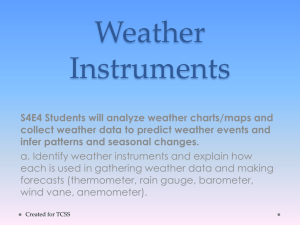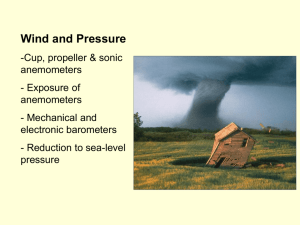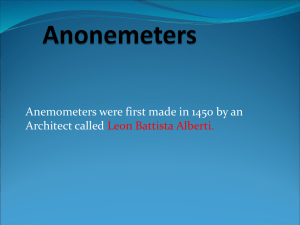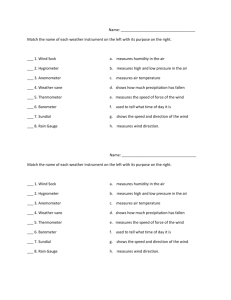Science Learning Community: Science and Engineering Lesson Plans Build an Anemometer
advertisement
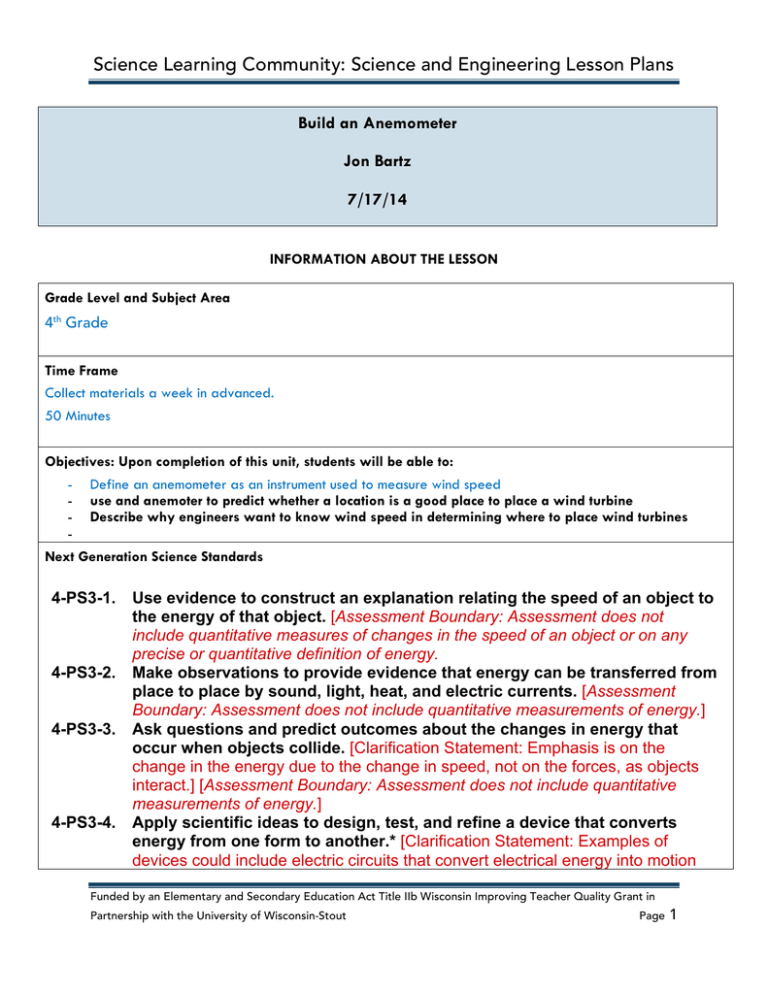
Science Learning Community: Science and Engineering Lesson Plans Build an Anemometer Jon Bartz 7/17/14 INFORMATION ABOUT THE LESSON Grade Level and Subject Area 4th Grade Time Frame Collect materials a week in advanced. 50 Minutes Objectives: Upon completion of this unit, students will be able to: - Define an anemometer as an instrument used to measure wind speed - use and anemoter to predict whether a location is a good place to place a wind turbine - Describe why engineers want to know wind speed in determining where to place wind turbines Next Generation Science Standards 4-PS3-1. 4-PS3-2. 4-PS3-3. 4-PS3-4. Use evidence to construct an explanation relating the speed of an object to the energy of that object. [Assessment Boundary: Assessment does not include quantitative measures of changes in the speed of an object or on any precise or quantitative definition of energy. Make observations to provide evidence that energy can be transferred from place to place by sound, light, heat, and electric currents. [Assessment Boundary: Assessment does not include quantitative measurements of energy.] Ask questions and predict outcomes about the changes in energy that occur when objects collide. [Clarification Statement: Emphasis is on the change in the energy due to the change in speed, not on the forces, as objects interact.] [Assessment Boundary: Assessment does not include quantitative measurements of energy.] Apply scientific ideas to design, test, and refine a device that converts energy from one form to another.* [Clarification Statement: Examples of devices could include electric circuits that convert electrical energy into motion Funded by an Elementary and Secondary Education Act Title IIb Wisconsin Improving Teacher Quality Grant in Partnership with the University of Wisconsin-Stout Page 1 Science Learning Community: Science and Engineering Lesson Plans 4-ESS31. energy of a vehicle, light, or sound; and, a passive solar heater that converts light into heat. Examples of constraints could include the materials, cost, or time to design the device.] [Assessment Boundary: Devices should be limited to those that convert motion energy to electric energy or use stored energy to cause motion or produce light or sound.] Obtain and combine information to describe that energy and fuels are derived from natural resources and their uses affect the environment. [Clarification Statement: Examples of renewable energy resources could include wind energy, water behind dams, and sunlight; non-renewable energy resources are fossil fuels and fissile materials. Examples of environmental effects could include loss of habitat due to dams, loss of habitat due to surface mining, and air pollution from burning of fossil fuels.] Standards for Technological Literacy 3-­‐5-­‐ETS1-­‐1. Define a simple design problem reflecting a need or a want that includes specified criteria for success and constraints on materials, time, or cost. 3-­‐5-­‐ETS1-­‐2. Generate and compare multiple possible solutions to a problem based on how well each is likely to meet the criteria and constraints of the problem. 3-­‐5-­‐ETS1-­‐3. Plan and carry out fair tests in which variables are controlled and failure points are considered to identify aspects of a model or prototype that can be improved. Common Core State Standards in Mathematics 6. Find whole-number quotients of whole numbers with up to four-digit dividends and two digit divisors, using strategies based on place value, the properties of operations, and/or the relationship between multiplication and division. Illustrate and explain the calculation by using equations, rectangular arrays, and/or area models. (Grade 5) [2010] 7. Add, subtract, multiply, and divide decimals to hundredths, using concrete models or drawings and strategies based on place value, properties of operations, and/or the relationship between addition and subtraction; relate the strategy to a written method and Funded by an Elementary and Secondary Education Act Title IIb Wisconsin Improving Teacher Quality Grant in Partnership with the University of Wisconsin-Stout Page 2 Science Learning Community: Science and Engineering Lesson Plans explain the reasoning used. (Grade 5) [2010 Common Core State Standards in English and Language Arts ELA/Literacy – RI.4.1 Refer to details and examples in a text when explaining what the text says explicitly and when drawing inferences from the text. (4-PS3-1) RI.4.3 Explain events, procedures, ideas, or concepts in a historical, scientific, or technical text, including what happened and why, based on specific information in the text. (4PS3-1) RI.4.9 Integrate information from two texts on the same topic in order to write or speak about the subject knowledgeably. (4-PS3-1) W.4.2 Write informative/explanatory texts to examine a topic and convey ideas and information clearly. (4-PS3-1) 7. 8. W.4.7 Conduct short research projects that build knowledge through investigation of different aspects of a topic. (4-PS3-2),(4-PS3-3),(4-PS3-4) W.4.8 Recall relevant information from experiences or gather relevant information from print and digital sources; take notes and categorize information, and provide a list of sources. (4-PS3-1),(4-PS3-2),(4-PS3-3),(4-PS3-4) 9. W.4.9 Draw evidence from literary or informational texts to support analysis, reflection, and research. (4-PS3-1) Mathematics – 4.OA.A.3 Solve multistep word problems posed with whole numbers and having whole-number answers using the four operations, including problems in which remainders must be interpreted. Represent these problems using equations with a letter standing for the unknown quantity. Assess the reasonableness of answers using mental computation and estimation strategies including rounding. (4-PS3-4) Prior Learning Do you know what a wind vane is? Sometimes it is shaped like a rooster and is located on a barn's roof? It is also called a weather vane. It spins in the wind, and shows us the direction from which the wind is coming. Well, typically an anemometer is also fitted with a wind vane to indicate the wind direction. Materials 4 small paper cups Push pin Sharpened pencil with eraser on the end Watch, clock or timer Stiff, corrugated cardboard (enough to cut two, same-size strips, each 13 to 23 cm [5 to 9 in] long for each team; used boxes are ideal) Modeling clay (about 85 grams or 3 oz or ¼ cup) Scissors Marking pens Rulers (for measuring) Funded by an Elementary and Secondary Education Act Title IIb Wisconsin Improving Teacher Quality Grant in Partnership with the University of Wisconsin-Stout Page 3 Science Learning Community: Science and Engineering Lesson Plans Stapler Anemometer Worksheet LESSON IMPLEMENTATION Objective: Upon completion of this lesson, students will be able to: - Define an anemometer as an instrument used to measure wind speed - use and anemoter to predict whether a location is a good place to place a wind turbine - Describe why engineers want to know wind speed in determining where to place wind turbines [State the learning objective for the lesson, which may be repeated from the unit objectives.] Pre-Assessment How can we tell the difference between a windy day and a really windy day? We measure the speed of the wind. Wind over land is sometimes measured in kilometers (or miles) per hour. Wind over water is sometimes measured in units called knots. How do we measure wind speed? We use a special instrument called an anemometer. Wind speeds are usually measured using a cup anemometer. A cup anemometer has a vertical pole with three cups that capture the wind. The number of times the cups spin around per minute is counted electronically. This type of anemometer is commonly seen on weather stations and is often used in our weather reports on the news. Do you know what a wind vane is? Sometimes it is shaped like a rooster and is located on a barn's roof? It is also called a weather vane. It spins in the wind, and shows us the direction from which the wind is coming. Well, typically an anemometer is also fitted with a wind vane to indicate the wind direction. Engineers design anemometers to measure wind speed for many situations other than for weather measurements. For example, anemometers are used to determine the how much airflow is entering or exiting mines, to make certain that miners have adequate ventilation and have enough air to breathe in the underground caves. Engineers also design other anemometers that use lasers to detect changes in light waves reflected from the air molecules in wind. Engineers have created hot wire anemometers that detect the wind speed through very tiny temperature differences between wires placed in the wind and in the wind shadow. All of these non-mechanical anemometers can be much more accurate, but also more expensive than a simple cup anemometer. The advantage of non-mechanical anemometers may be that they are less sensitive Funded by an Elementary and Secondary Education Act Title IIb Wisconsin Improving Teacher Quality Grant in Partnership with the University of Wisconsin-Stout Page 4 Science Learning Community: Science and Engineering Lesson Plans to icing, so they are able to make measurements in all weather, even winter. Cup anemometers are sometimes heated so they can work in cold weather. Where would you locate a wind farm? Anemometers are also important instruments for determining the best locations for wind power generators, or wind turbines, especially since the direction and strength of the wind is very dependent on local terrain. Wind turbines are machines that convert the moving energy of wind into mechanical/electrical energy for us to use, like a windmill. Also, wind speed changes with height, so engineers use anemometers to determine the best height to place the turbine. Wind turbines need a constant, average wind speed of about 23 kilometers (14 miles) per hour before the wind turbines can generate electricity. It is very important that these wind speed measurements be very accurate because any error in wind speed will be greatly magnified. For example, if your anemometer overestimates the wind speed by 10%, you overestimate the power by roughly 133%, or one third too much. Today, we are going to become engineers and build our own simple anemometers. With these instruments, we can figure out the best place around our school to place a wind turbine. Procedures Time # min.s Weeks Before 1 or 2 class periods Before the Activity A few days in advance, collect used corrugated cardboard boxes. Gather all the materials and make copies of the Anemometer Worksheet. With the Students 1.Divide the class into teams of two students each. Provide each team with materials and a work space. 2.Have the students color the outside of one paper cup with the marking pen. 3.Next, have them cut from the corrugated cardboard boxes two, same-size strips, each 13 to 23 cm (5 to 9 in) long. Use the rulers, as necessary. These will be the anemometer blades. 4.Cross the cardboard strips so they make a plus (+) sign. Staple them together in the middle, where they cross (see Figure 1), making sure Purpose Collect Materials to use. Things to accomplish for the day. Funded by an Elementary and Secondary Education Act Title IIb Wisconsin Improving Teacher Quality Grant in Partnership with the University of Wisconsin-Stout Page 5 Science Learning Community: Science and Engineering Lesson Plans the anemometer blades are of equal length. Use the rulers to measure the blades and locate the exact center. 5.Staple one cup, turned sideways, to the end of each cardboard blade, making sure the cups all face the same direction. 6.Push the pin through the center of the cardboard cross and attach it to the eraser point of the pencil. Blow on the cups to make sure the cardboard blades spin freely on the pin. 7.Take the students outside (perhaps to the playground area) with their anemometers and modeling clay. Have the student teams each choose a location at which they would like to measure the wind speed. 8.Have the students place the modeling clay on a stable surface, such as a fence rail, a wall or a rock. Stick the sharpened end of the pencil into the clay mound, so it stands up straight and holds the anemometer securely. 9.Measure the wind speed by counting the number of times the anemometer spins around in a minute (rotational rate). Point out how it helps to keep track of the number of spins by watching the movement of the cup with the markings. Students should take three measurements at their location and calculate the average rotational rate. Record measurements and observations on the Anemometer Worksheet. 10. Have student team members work together to complete the worksheet. Conclude with a class-wide comparison of each team's results (see the Engineering Your Playground post-activity assessment in the Assessment section). What are the wind patterns in the playground area? Which is the windiest location? The calmest location? Steady winds? Gusty winds? Why (or why not) are these good locations for placing a wind turbine? Funded by an Elementary and Secondary Education Act Title IIb Wisconsin Improving Teacher Quality Grant in Partnership with the University of Wisconsin-Stout Page 6 Science Learning Community: Science and Engineering Lesson Plans Formative Assessment Pre-Activity Brainstorming: In small groups engage the students in open discussion to think of locations where it can be really windy and not so windy. Remind them that no idea or suggestion is “silly.” All ideas should be respectfully heard. Have one student from each team write their ideas on the board to share with the class. Prediction: Have the students suggest areas around the outside of the school where it might be the windy and list them on the board. Have students predict which locations might be the windiest and record predictions on the board. Closure [At the conclusion of the lesson, closure is the time to help the students organize the information that has been presented to aid their retention. The students should do the thinking and discussion rather than the teacher. The teacher can engage them in a short review by posing questions. The students should be given a chance at the end of the lesson to personally reflect on the lesson, to share their ideas with others and with the class as a whole.] Engineering Your Playground: Use the class data to determine the wind patterns of the playground (or area that you used in this activity). Have students draw a map of this area and write the wind speeds for the different locations on it. Have a student draw a wind turbine in the best location on this map and explain why s/he chose that spot. Toss-a-Question: Provide students with a list of questions (see below). Students work in groups and toss a ball or wad of paper back and forth. The student with the ball asks a question and then tosses the ball to someone to answer. If a student does not know the answer, s/he tosses the ball onward until someone gets it. The person who gets the answer correct gets to start the next question. Review the answers at the end. Possible questions/answers: How does an anemometer measure wind speed? (Answer: Wind hitting the cups of the anemometer causes the anemometer to rotate. The rate of the rotation of the anemometer is related to wind speed.) Why would you want to know the wind speed? (Possible answers: To know how to dress for the weather. To determine if it is a good day to play tennis outside. To decide if it is a good day to have a picnic, read outside or fly a kite.) Why would you want to know the wind direction? (Possible answers: To get a kite started. To set up a badminton or volleyball court to be fair for each side. To find a sheltered spot in your yard for a pet. To maneuver the sail on a sailboat, or safely land a plane.) Why would an engineer want to know the wind speed? (Answer: Engineers use Funded by an Elementary and Secondary Education Act Title IIb Wisconsin Improving Teacher Quality Grant in Partnership with the University of Wisconsin-Stout Page 7 Science Learning Community: Science and Engineering Lesson Plans wind speed to determine the location to place wind turbines, detect weather patterns and determine air flow, such as air flow for mine ventilation.) Why do engineers need to use anemometers in deciding where to put wind turbines? (Answer: Wind generators produce much more electricity at locations of steady, high wind speed.) Where might an engineer locate a small wind turbine used for generating electricity for a single home? (Possible answers: On the roof of the house, on a hill by the house, or on a pole up high near the house.) Summative Assessment Activity Embedded Assessment Worksheet: Have the students record their measurements and complete the Anemometer Worksheet as a team. Review their answers to gauge their mastery of the subject. References: http://www.teachengineering.org/view_activity.php?url=collection/cub_/activities/cub_energ y2/cub_energy2_lesson07_activity1.xml [Repeat this table for each additional lesson, as needed. To follow the model used by EiE, consider including a lesson to introduce the context of the engineering problem (lesson one), a lesson to gather background information on the problem and type of engineering (lesson two), a lesson to plan solutions and test materials (lesson three), and a lesson for creating and improving your design (lesson four).] Funded by an Elementary and Secondary Education Act Title IIb Wisconsin Improving Teacher Quality Grant in Partnership with the University of Wisconsin-Stout Page 8


